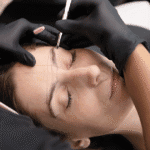Smoker’s Lines and Their Impact on Aesthetics
Smoker’s lines, also known as perioral wrinkles, are the fine lines that develop around the lips, often due to aging, smoking, or repetitive facial movements. These lines can make lips appear thinner and less youthful, affecting overall facial aesthetics. However, innovative treatments like radiofrequency (RF) therapy offer a modern, non-invasive solution for smoother, more youthful lips.
Radiofrequency Technology: The Science Behind the Rejuvenation
Radiofrequency technology works by utilizing electromagnetic waves to penetrate the skin’s layers and stimulate collagen production deep within. When RF energy is applied to the skin, it generates controlled heat, targeting the dermal layers. This heat promotes blood circulation, boosts cell regeneration, and ultimately firms the skin. The key advantage of RF over other skin tightening methods is its ability to reach deeper skin layers without causing damage to the outer surface. This makes RF an ideal treatment for delicate areas like the lips, where the skin is thinner and more sensitive. By promoting collagen production, RF tightens the skin, reducing the appearance of wrinkles and giving the lips a rejuvenated, plump look.
The Mechanism of RF for Smoker’s Lines
RF energy causes water molecules in the skin cells to vibrate rapidly, generating heat between 40°C to 43°C. This temperature range is crucial for triggering the contraction of collagen fibers and stimulating their regeneration. The thermal effect re-organizes collagen fibers in a more structured way, which enhances skin elasticity and tightens sagging areas. In the case of smoker’s lines, RF helps repair aging and damaged collagen, smoothing out fine lines around the lips and restoring youthful volume. For smoker’s lines specifically, RF therapy can deliver visible results with minimal discomfort. By targeting deep tissue, RF promotes skin tightening from within, making it an effective method to combat fine lines without invasive procedures.
Tips for Preventing and Reducing Smoker’s Lines
While radiofrequency is a powerful tool in combating smoker’s lines, prevention is just as important.
- Quit Smoking: Smoking accelerates skin aging, decreasing collagen and elastin. Ceasing this habit reduces further damage.
- Stay Hydrated: Drinking enough water helps maintain skin elasticity and minimizes the appearance of fine lines.
- Moisturize Regularly: Use hydrating products to keep the skin around your lips plump and smooth.
- Use Sunscreen Daily: Protect your skin from UV damage, which can deepen wrinkles and hinder skin healing.
- Healthy Diet: Consuming foods rich in antioxidants supports collagen production and skin regeneration.
- Facial Exercises: Strengthen the muscles around your lips by performing regular facial exercises, which can help tone and tighten the skin.
- Get Enough Sleep: Sleep promotes skin regeneration, helping your skin heal and repair naturally.
- Avoid Excessive Alcohol Consumption: Alcohol can dehydrate your skin, leading to increased wrinkling over time.
- Use Retinol Creams: Retinol can boost collagen production and improve skin texture, reducing fine lines and wrinkles.
Combining these habits with RF therapy can give you long-lasting, smoother skin around your lips.
Conclusion
Radiofrequency therapy offers an effective, non-invasive solution to reduce smoker’s lines and enhance lip appearance. The treatment’s ability to stimulate collagen production and tighten skin makes it an excellent choice for individuals seeking smoother, more youthful lips. With minimal discomfort and long-lasting results, RF presents a safe alternative to traditional methods like surgery or fillers. If you’re looking to rejuvenate your lips and regain a youthful appearance, RF technology might be the perfect solution for you. Be sure to consult with a professional to determine the best treatment plan for your needs.








